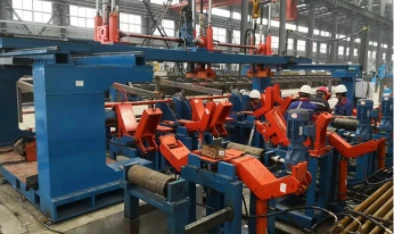high frequency pipe welding machine
High-Frequency Pipe Welding Machines Advancements and Applications
In the world of industrial manufacturing, the efficiency and quality of pipe welding are paramount, particularly in sectors like construction, petrochemical, and energy. Among the various welding techniques available, high-frequency pipe welding has emerged as one of the most effective and reliable methods. This article explores the advancements in high-frequency pipe welding machines, their operational principles, applications, and advantages.
Understanding High-Frequency Welding
High-frequency welding, also known as high-frequency induction welding, uses electromagnetic induction to heat and join metal pipes or tubes. The process involves generating high-frequency electric currents that induce heat in the material. As the temperature rises, the edges of the pipes or tubes are pressed together, allowing for a strong bond to be created without the need for additional filler materials. This method is particularly suitable for welding thin-walled pipes, making it a preferred choice in many applications.
Key Features of High-Frequency Pipe Welding Machines
The latest high-frequency pipe welding machines come equipped with advanced features that enhance their functionality and user-friendliness. Some significant characteristics include
1. Precision Control Modern machines are designed with advanced control systems that allow for precise adjustments to be made during the welding process. This ensures consistent quality and reduces the risk of defects.
2. Automation Automation features facilitate the integration of these machines within larger manufacturing systems. With programmable settings and automatic adjustments, operators can enhance production efficiency while minimizing manual intervention.
3. Compact Design Many high-frequency welding machines are now designed to be more compact, which saves valuable floor space in workshops and manufacturing plants. This is particularly advantageous in modern production environments where space is often at a premium.
4. Versatility These machines can be used to weld a variety of pipe sizes and materials, including carbon steel, stainless steel, and alloys. Their versatility makes them suitable for different industries and applications.
Applications
High-frequency pipe welding machines find applications across various industries
1. Oil and Gas In the oil and gas sector, pipes must be welded to withstand high pressures and corrosive environments. High-frequency welding ensures robust joints that are essential for maintaining pipeline integrity.
high frequency pipe welding machine

2. Construction The construction industry utilizes high-frequency welding for structural pipes and scaffolding. This technique provides the strength and durability required for safety-critical applications.
3. Automotive In automotive manufacturing, pipes used in exhaust systems and other components are often welded using high-frequency techniques to ensure lightweight yet durable connections.
4. HVAC Systems High-frequency welding is used in the fabrication of HVAC tubing, allowing for tight seals and efficient thermal transfer.
5. Shipbuilding The shipbuilding industry relies on high-frequency welding to join the pipes used in ship hulls and systems, ensuring their resilience against harsh marine environments.
Advantages
The advantages of high-frequency pipe welding are manifold
1. Speed The high-speed nature of the welding process allows for increased production rates, which is essential in meeting large-scale manufacturing demands.
2. Strength High-frequency welding creates strong and durable joints that can withstand significant mechanical and environmental stresses.
3. Reduced Heat Input The localized heating reduces the overall heat input into the material, minimizing warping and distortion, which can be critical for certain applications.
4. Cost-effective The efficiency and speed of high-frequency welding can lead to reduced labor costs and improved resource utilization, which ultimately translates to lower production costs.
5. Environmentally Friendly This welding method produces less waste and requires fewer consumables, making it a more sustainable option compared to traditional welding techniques.
Conclusion
High-frequency pipe welding machines are at the forefront of modern manufacturing, driving advancements in speed, efficiency, and quality. As industries continue to evolve and demand higher standards, high-frequency welding will play a critical role in meeting these challenges. With ongoing technological developments, the future of pipe welding looks promising, offering innovative solutions to meet the growing needs of various sectors. As companies invest in high-frequency machines, they not only enhance their production capabilities but also contribute to the sustainability and resilience of their operations.
-
High Frequency Straight Seam Welded Pipe Production Line-BzZhou Xinghua Machinery Equipment Manufacturing Co., LTD.|line pipe steel&welded gas pipeNewsJul.30,2025
-
High Frequency Straight Seam Welded Pipe Production Line-BzZhou Xinghua Machinery Equipment Manufacturing Co., LTD.|High Precision&Automated SolutionsNewsJul.30,2025
-
High Frequency Straight Seam Welded Pipe Production Line - BzZhou Xinghua Machinery Equipment Manufacturing Co., Ltd.NewsJul.30,2025
-
High Frequency Straight Seam Welded Pipe Production Line-BzZhou Xinghua Machinery Equipment Manufacturing Co., LTD.|Precision Welding, High EfficiencyNewsJul.30,2025
-
High Frequency Straight Seam Welded Pipe Production Line|BzZhou Xinghua|Precision Welding&EfficiencyNewsJul.30,2025
-
High Frequency Straight Seam Welded Pipe Production Line - BzZhou Xinghua|Precision Engineering&EfficiencyNewsJul.30,2025


